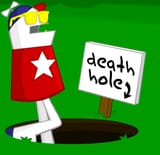>>720060775
I think the problem is how linear most SRPGs are, especially because of how story focused they are.
There is little choice in strategy, you need to beat this encounter that's it, figure out a "strategy" to beat it.
there is no choice of places to go, encounters to try.
if you had say 5 avenues you were progressing at the same time, run into a wall in one of them and realize you might need some way to deal with X from trying a fight and losing, then you go elsewhere and find something to deal with X you have made progress despite losing.
Knowledge is progress.
one of the biggest reasons losing can be shitty in SRPG's is because of how long the fights take, very slow animations for every single attack and thing, having to wait for them to conclude before you can do anything, just very poorly made and bad design decisions. And for what, most people will just max out animation speed and not even look at them, just let animations play while you put in other actions so players can both see them and still be playing the game.
If your game sucks to make you want to try again, then you don't really want to try to learn from fights to give them another go later.
goals beyond "kill all enemies" is also great, but are usually done poorly in pretty much every story focused SRPG while more gameplay focused ones usually do a good job of it.
look at something like troubleshooter, very few missions are about actually killing all the enemies, usually they are about accomplishing certain objectives, surviving for long enough, etc, with many optional objectives and different ways to complete missions, so you can easily set your sights on a full completion, not make that, but still did enough to accomplish the main goal.
there is a lot of design space that I can see but very few games in the genre even attempt to take advantage of with minimal deviation from "kill all enemies"

























































